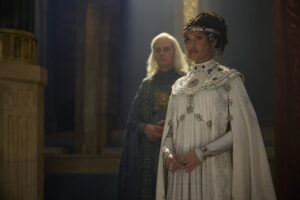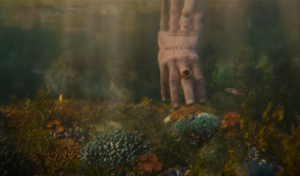MAJOR SPOILERS FOR THE RINGS OF POWER SEASON TWO, EPISODE THREE AHEAD!
The fact that it takes The Rings Of Power three whole episodes, almost half its second season, just to reintroduce all of the major characters from the first is demonstrative of a major structural weakness: it doesn’t have enough time or space for all the far-flung subplots it insists on treating as though they do anything to advance what is in theory if not in execution the overarching narrative of this season. That’s not to say that spending time in Pelargir with Isildur (Maxim Baldry) and the Southlander refugees is unimportant in the long run, but here and now it absolutely is, and every second spent there is a second that could have gone towards further fleshing out Celebrimbor (Charles Edwards) and his relationship with Annatar (Charlie Vickers), or the bare-bones story of how the titular Rings of Power come to be, which is currently being told in bits and pieces between the substantial blocks of screentime devoted to peripheral characters.

Even the most critical subplot on the show, that of Númenor and its people, is being shortchanged. We spend a grand total of fifteen minutes on the island kingdom of Men in the third episode, jumping straight into a funeral ceremony for a character most casual viewers have probably forgotten entirely in the intervening two years since the first season finale where he quietly passed away; King Tar-Palantir. The audience has no emotional attachment to him, which is fine, we don’t necessarily need to care about the guy to understand that his death marks a turning-point in Númenor’s history…unfortunately, the extremely brief sequence doesn’t convey the magnitude of the moment either, instead feeling oddly hollow and mundane.
The parts needed to assemble a compelling story rife with political intrigue are all there – the old king’s unpopular daughter Míriel (Cynthia Addai-Robinson), already acting as his regent, stands poised to take the throne, as is her right, while her charismatic cousin Pharazôn (Trystan Gravelle) is positioning himself as the figurehead for a revolution – but there’s only so much that can be done with them in under a quarter of an hour, and taking time across multiple episodes to build slowly towards the inevitable coup isn’t really an option when the season is already close to being over.
This may be the result of a disagreement between the show’s editors and producers over how much screentime to give the Numenoreans, reported on by Fellowship Of Fans in August of last year, though not knowing how many and what kind of scenes were left on the cutting-room floor, I can’t definitively say that their inclusion would have helped – besides which, I can’t pass judgement on what I imagine we might have seen from this subplot (ideally, a gripping succession drama rivaling House Of The Dragon‘s in terms of complexity and depth), only the version that Amazon saw fit to release into the world: which it brings me no pleasure to report lacks any and all of the aforementioned qualities.
While the character of Pharazôn stands out in his few scenes, entirely due to Gravelle’s spellbinding performance, he is also the greatest victim of the edit – or, perhaps, the writers? Whoever it was, let me say, that made him an opportunistic spectator to the coup we are meant to understand was the culmination of his political machinations. He certainly doesn’t shoot down any of the treasonous ideas being bandied around the dinner-table by the overtly duplicitous Lord Belzagar (Will Keen) and the ambitious young architecture student Eärien (Ema Horvath), but he seems almost disinterested in their conversation himself. It is Eärien who disrupts Míriel’s coronation ceremony by exposing the Queen Regent’s treasured seeing-stone, her palantír, and Belzagar who spins the arrival of an Eagle of Manwë (obviously intended for Míriel) into a sign for Pharazôn and leads the crowd in chanting his name.

Pharazôn, for his part, gives Míriel one last chance before her coronation to simply follow his counsel, offering her a choice between a red gown he says represents Númenor’s glorious future and a white gown representing its somber past. Míriel chooses the white, declaring it the “humbler” of the two options. Humble is perhaps not the word I would use to describe any dress that comes with a mother-of-pearl mosaic collar, but then, I am not a Númenórean monarch. It is a gorgeous piece, far and away my favorite costume on the show, and you can read my interview with The Rings Of Power‘s costume designer Luca Mosca, where I asked about it specifically, here. Pharazôn, however, is visibly irritated by her virtuosity. If the idea is that he might have called off the coup if she had chosen differently (i.e. demonstrating willingness to be molded into a more pragmatic leader), it’s not explored any further, and just makes Pharazôn seem confused.
It’s a great scene for Míriel, though. Some viewers may find her staunch faith and moral integrity to be uninteresting qualities, but I see her as The Rings Of Power‘s most quintessentially Tolkienian protagonist: noble, fair and cold, in possession of a quiet strength she does not project outwardly, because she does not seek to be regarded as unassailable or unapproachable. This is illustrated beautifully when she embraces a grieving mother who had slapped her across the face just moments before, taking that nameless woman’s pain and sorrow upon herself as if it were her own. She may not have Pharazôn’s skill for addressing crowds and choosing words that can apply to many situations, but one-on-one, she is the more genuinely compassionate of the two. And most of that is down to Addai-Robinson, who on top of everything else, is playing a blind Míriel in The Rings Of Power season two (something that the show, admittedly, hasn’t done much with, but which factors into the fear that she is “weaker” since coming back from Middle-earth).
Apart from these two, no one else in Númenor has had enough screentime to make a strong impression this season. Eärien’s grief and rage over her brother Isildur’s apparent death in the Southlands, the driving factor behind her decision to break away from her father Elendil (Lloyd Owen) and join Pharazôn in overthrowing the Queen Regent, is referenced once or twice, giving her at least the impression of interiority, but her boyfriend Kemen (Leon Wadham), Pharazôn’s son, exists solely to fill out crowd shots as far as I can tell. Even Elendil just stands around. His only scene with any meat on its bones is one that’s been copy-and-pasted over from the first season – specifically, the scene in which Elendil, unable to calm Isildur’s distraught horse Berek, lets the animal run free in the Southlands.

The scene ended there in season one, but this time we follow Berek back to the place where he lost his rider, amongst the smoking rubble of what used to be the human village of Tirharad, before Adar (Sam Hazeldine) and his Orcs moved in. Wandering into a nearby cave, he finds Isildur trussed up in webs, in line to be devoured by Shelob. The iconic monster’s inclusion in The Rings Of Power is, unfortunately, the most shameless form of fan-service: she could just as easily have been a creature invented for the show, like the mud-worm in episode four. You won’t learn anything about her that you don’t already know from the books or movies, though in fairness, I suppose there’s not much more to know. She’s a giant spider that eats people (even her brood-mother Ungoliant is just a giant spider that eats everything; these are not exactly Tolkien’s most complex characters we’re talking about here). While the sequence in Shelob’s lair isn’t likely to be anyone’s highlight of the season, it kicks the episode into gear – and as an arachnophobe, Shelob’s design and movements are all sorts of icky. She is smaller and less heavily armored than in The Lord Of The Rings, but what she lacks in size she makes up for with increased speed and agility.
Just as the ancient hero Beren, fleeing from giant spiders, stumbled upon Lúthien dancing in a hemlock grove in the Forest of Doriath, so Isildur escapes Shelob and meets Estrid (Nia Towle) – but the similarities between their love stories end there. Estrid, mistaking Isildur for an Orc, stabs him in the thigh, and then, while apologizing profusely, pulls the knife out of the wound (big no no), setting the tone for their interactions going forward. They make a pretty cute couple, if you like your romantic leads to share exactly one braincell between them. Estrid’s theme, softly undulating with a hint of mystery, also happens to be my favorite track off the OST. But is that enough to justify her and Isildur’s combined screentime greatly exceeding that of Celebrimbor and Sauron in this episode?
Once they’ve reached their destination, the Númenórean outpost of Pelargir, and linked up with the Southlander refugees, Isildur and Estrid’s short-term goals are fulfilled – sure, Isildur wants to go home and reunite with his family and friends, but he’s safe, and the show could have conceivably left him and Estrid there until a more opportune moment to pick up their story thread again. It doesn’t do that, which is why we end up lingering in the Southlands far longer than was probably necessary, with a pair of Ent serial killers and the “Wild Men”, the show’s term for the Southlanders who have chosen to serve Adar (no relation to the Wild Men in The Lord Of The Rings). I strongly suspect that Nazanin Boniadi’s herbalist-turned-reluctant-leader Bronwyn, the season one protagonist of the Southlands subplot, would have somehow provided the connective tissue between these leftover pieces of a narrative: but Boniadi chose not to return for The Rings Of Power‘s second season and the role was not recast. She is instead revealed to have died offscreen, leaving her son Theo (Tyroe Muhafidin) an orphan and the Southlanders leaderless.
Regardless of intent, Bronwyn’s death accentuates the themes that underpin all of J.R.R. Tolkien’s stories of Middle-earth, this one especially: the inevitability of death, and the fear of it. That fear is the driving force behind the creation of the Rings of Power, something the show was trying (albeit awkwardly) to convey in season one when it imposed a deadline on the Elves to either halt the effects of the passage of time on their bodies and souls, leave Middle-earth forever and return west across the sea to the Undying Lands, or fade, becoming intangible and powerless. In season two, the show gets the same idea across more gracefully using the Dwarves of Khazad-dûm, whose survival is dependent on a resource – sunlight – they have precious little of, and less and less with each tremor that threatens to bring the weight of the Misty Mountains down upon their heads. Celebrimbor, the smith who saved the Elves, is happy to help the Dwarves out of their own predicament, and no less so when Sauron shyly confesses that High King Gil-galad has forbade the making of any more Rings.

But while it would be no overstatement to say this is the single most important plot development of the season thus far, The Rings Of Power doesn’t communicate that by giving the lion’s share of screentime to a character like Isildur, who has plenty of time still to morph into a convincing protagonist before he’s called upon to perform the great deeds that will make him a household name. I’m doing my best not to spoil what’s coming for Celebrimbor, but he doesn’t have much time left, and the show needs to do a better job – and quickly – of managing its jostling subplots so they’re not squeezing the “A” story.
Episode Rating: 6.5/10













